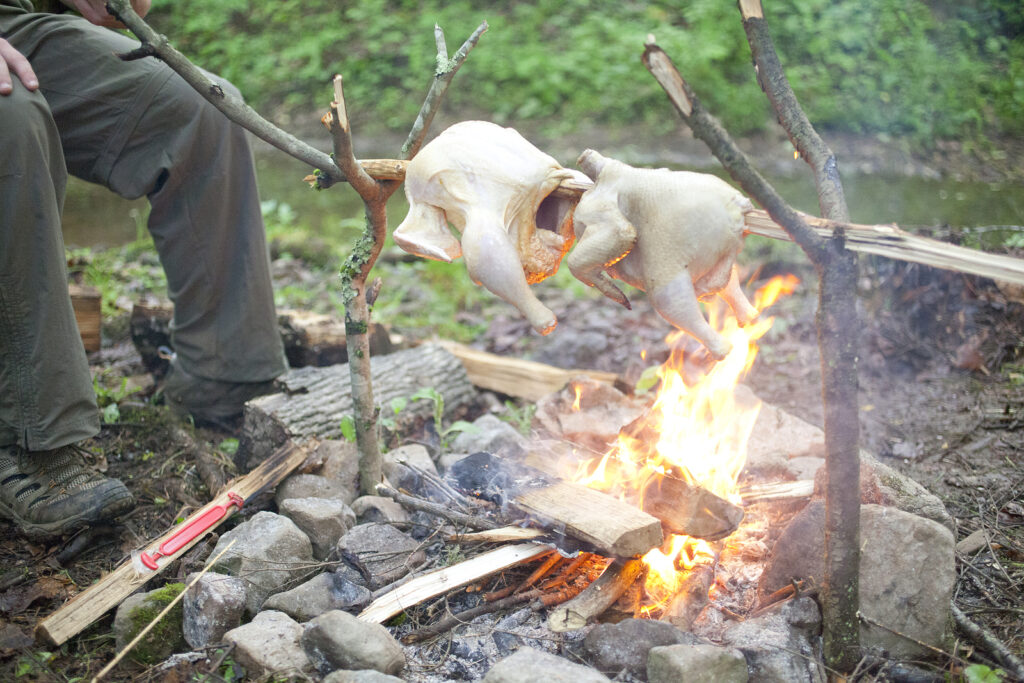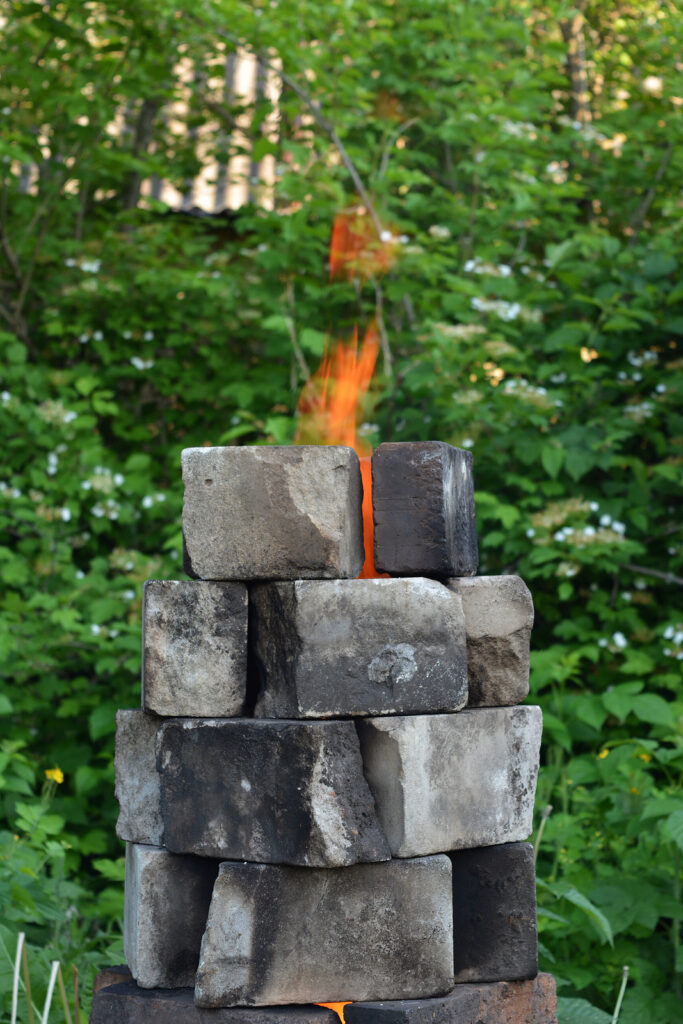Outdoor Fireplace DIY
Picture those delightful evenings spent beneath the starry sky, embraced by the comforting radiance of my very own outdoor fireplace. Constructing this outdoor gem has not only been a thrilling DIY adventure but also an enriching addition to my cherished outdoor haven.
In this detailed guide, I'll personally guide you through the process of crafting your own outdoor fireplace, a weekend project that has transformed my outdoor living space. Whether you're a seasoned DIY enthusiast like me or a newcomer eager to embark on this fulfilling journey, join me as I share my experiences and insights to help you create your dream wood for outdoor fireplace.
Why Build an Outdoor Fireplace?
Enhanced Aesthetics and Focal Point
Incorporating an outdoor fireplace into your garden or patio can significantly elevate the visual appeal of your outdoor living area. The vast array of designs available means you can choose a style that complements your existing landscaping or architectural elements, making it a captivating focal point that enhances the overall beauty of your outdoor fire pit space.
Increased Property Value
Outdoor fire features, such as fireplaces and fire pits, are known to add significant value to a home. Potential buyers often find these amenities attractive, leading to a higher resale value for properties that have them. This investment not only enhances your enjoyment of the space but also potentially pays off when it's time to sell.
Extended Outdoor Enjoyment
One of the most compelling reasons to invest in an outdoor fireplace is the ability to extend your outdoor enjoyment throughout the year. During colder months, the warmth and ambiance of a well-designed fireplace can make your to build an outdoor space comfortable and inviting, allowing you to gather with friends and family even when the temperature drops. This extended usability can truly transform your property into a year-round oasis for relaxation and entertainment.
Cooking and Entertaining
Outdoor fireplaces can serve as versatile cooking hubs. Many come equipped with built-in grills or pizza ovens, allowing you to prepare delicious meals while enjoying the outdoors. This makes it an ideal spot for hosting BBQ parties, roasting marshmallows, or simply enjoying a cozy dinner al fresco.
Ambiance and Relaxation
The crackling sound of a fire and the warm, flickering glow create a unique ambiance that promotes relaxation and serenity. Whether you're unwinding after a long day, reading a book, or stargazing, an outdoor fireplace can provide a tranquil setting for moments of solitude and reflection.
Mosquito and Insect Control
The smoke generated by an outdoor fireplace can act as a natural deterrent for mosquitoes and other insects. This can be particularly beneficial during the warmer months, allowing you to enjoy your outdoor fireplace how to build space without the nuisance of pesky bugs.

Choosing the Right Location
- Safety First – Keep Your Distance: Prioritize safety by positioning your outdoor fireplace at least 10 feet away from your home, trees, or any other structures. This ensures that sparks or embers won't pose a fire hazard to your property or neighboring structures. Additionally, maintaining this safe distance reduces the risk of heat damage to nearby vegetation.
- Wind Protection: Be mindful of wind patterns in your outdoor space. Opt for a location that offers some natural shielding from strong winds. High winds can not only make your fireside experience less enjoyable but also pose safety risks by spreading smoke or sparks unpredictably.
- Proximity for Convenience: Striking a balance between proximity and safety is key. Place your outdoor fireplace close enough to your home for easy access, especially if you plan to use it for cooking or as a heat source during cooler months. However, ensure it's not so close that smoke finds its way inside your home. Adequate spacing can prevent smoke infiltration and keep indoor air quality unaffected.
- Optimal Viewing Experience: The positioning of your fireplace should also take into account the view. Arrange it in a way that allows you to make the most of your surroundings. Consider aspects such as sunset and star-gazing opportunities. A thoughtfully placed fireplace can enhance your outdoor experience by providing a visually captivating backdrop for relaxation and entertainment.
- Privacy and Social Layout: Think about how the placement of your outdoor fireplace fits into your overall outdoor living space. It can serve as a natural divider or focal point for seating areas, enhancing the flow and functionality of your outdoor environment. Consider the layout of seating and dining areas to ensure everyone has a clear view of the fire, fostering a cozy and social atmosphere.
- Local Regulations and Permits: Before finalizing your fireplace location, check local building codes and regulations. Some areas may have specific requirements regarding the placement and design of outdoor fire features. Obtaining any necessary permits ensures that your fireplace complies with safety standards and local ordinances.
- Environmental Considerations: Be mindful of environmental factors, such as prevailing winds and sunlight patterns. These elements can affect the overall comfort and usability of your outdoor space. For example, positioning the fireplace to catch the warmth of the morning sun can extend its functionality into the cooler hours of the day.
Designing Your Outdoor Fireplace
Designing your outdoor fireplace offers a creative opportunity to elevate your outdoor space's ambiance and functionality. Here, we delve into various design options to inspire your project:
Traditional Brick Design
If you're aiming for timeless elegance, a traditional brick fireplace is a popular choice. Its classic aesthetic blends seamlessly into most gardens and outdoor settings. Bricks not only offer durability but also contribute to a warm, inviting atmosphere. You can customize the brickwork to create intricate patterns or opt for a simpler, clean-lined design, depending on your preferences.
Stone Fireplac
For a rustic and robust appearance that exudes natural charm, consider a stone fireplace. The use of natural stone, such as granite or limestone, adds texture and character to your outdoor space. Each stone is unique, giving your fireplace a one-of-a-kind, earthy feel. You can embrace the irregularities in stone placement for a more organic look or opt for a more polished and structured design.
Modern Design
If your home boasts a contemporary style, a modern outdoor fireplace can be the perfect addition. These fireplaces feature sleek designs often incorporating metallic elements like stainless steel or aluminum. The result is a minimalist, chic look that complements the aesthetics of modern homes. Modern fireplaces can also include features such as remote control ignition and customizable flame settings for added convenience.
Customization
Beyond these broad categories, you have the option to customize your fireplace design to align with your unique vision. Consider elements like the fireplace's size, shape, and height. You can integrate seating options or create built-in storage for firewood and outdoor cooking accessories. Don't hesitate to incorporate personal touches that reflect your style and functional needs.
Sketch Your Design
As you explore design options, it's highly beneficial to sketch your envisioned fireplace layout. This not only helps you visualize the end result but also allows you to identify potential challenges or modifications needed. Collaborating with a professional designer or contractor can ensure that your design is not only aesthetically pleasing but also structurally sound and compliant with local building codes.
Materials and Finishes
Consider the materials and finishes for your fireplace carefully. From the type of bricks or stones to the choice of mortar and grout colors, every detail contributes to the overall look. You may also want to explore decorative elements like mantels, hearths, and accent lighting to enhance the fireplace's appeal.
Functionality and Safety
Don't forget to factor in the fireplace's intended use. If you plan to cook or grill over the fire, select materials that can withstand high temperatures. Additionally, ensure proper ventilation and safety features are integrated into the design to prevent accidents and maintain air quality.

Materials and Tools You’ll Need
Before embarking on your outdoor fireplace construction project, it's essential to gather all the required materials and tools to ensure a smooth and successful build. Here's an extensive list of what you'll need:
Materials:
- Firebrick: These specialized bricks are designed to withstand high temperatures, making them essential for the firebox's interior.
- Concrete Blocks or Pavers: These will form the structural foundation and body of the fireplace, providing stability and support.
- Mortar Mix: High-temperature mortar is crucial for creating a strong and durable bond between bricks and blocks.
- Metal Firebox or Fire Ring: These components help contain the fire and direct heat efficiently, ensuring safe and effective combustion.
- Rebar: Used for structural reinforcement, rebar enhances the overall strength and stability of the fireplace.
- Gravel: Required for creating a solid foundation beneath the fireplace structure, ensuring proper drainage and stability.
- Fireplace Cap: This protective component shields the top of your fireplace from the elements, preventing water and debris from entering.
- Flue Liner: Necessary for proper ventilation, the flue liner directs smoke and gases up and out of the chimney.
- Chimney Pipe: Connects to the flue liner and directs smoke further up and away from the fireplace area.
- Stucco or Stone Veneer: These materials are used for finishing the exterior of the fireplace, providing a decorative and weather-resistant surface.
- Fireplace Accessories: Including a grate, poker, and screen, these accessories enhance functionality and safety.
Tools:
- Trowel: Essential for spreading mortar evenly and effectively during construction.
- Level: Ensures that all components of the fireplace are aligned correctly and are level, preventing structural issues.
- Circular Saw with Masonry Blade: Necessary for cutting bricks, blocks, and other masonry materials to the desired size and shape.
- Rubber Mallet: Used to tap bricks and blocks into place, ensuring a snug fit and a stable structure.
- Measuring Tape: Helps you accurately measure and mark components during construction.
- Safety Gear: Includes gloves, safety glasses, and a dust mask to protect yourself while working with materials and tools.
- String Line: Provides a straight reference line for aligning bricks and blocks accurately.
- Broom: Used for cleaning up debris and ensuring a tidy work area.
Step-by-Step Guide to Building Your Outdoor Fireplace
Step 1: Ground Preparation
The foundation of your outdoor fireplace is crucial, and careful preparation is key:
- Excavate a Trench: Dig a trench about 6 inches deep in the chosen location for your fireplace. The trench should be slightly wider than the planned footprint to accommodate the structure's base and allow for proper drainage.
- Gravel Base: Fill the excavated trench with gravel, compacting it to create a level and stable foundation. Proper compaction ensures the even weight distribution of your fireplace and prevents settling over time.
Step 2: Laying the Foundation
With the groundwork laid, it's time to establish a solid foundation:
- Mortar Mix: Mix the mortar according to the manufacturer's instructions, ensuring it has the right consistency for secure bonding.
- Level the Base: Start by laying the first layer of bricks or stones on top of the gravel. Use a level to guarantee that this initial layer is perfectly level. A level foundation is essential for the stability and alignment of your fireplace.
Step 3: Building the Firebox
The firebox is the heart of your fireplace, and meticulous construction is imperative:
- Firebrick Selection: Choose firebricks for the firebox's interior. These specialized bricks are designed to withstand high temperatures, ensuring safety and longevity.
- Precise Placement: As you construct the firebox, ensure that the firebricks fit tightly against each other to create a robust, heat-resistant enclosure. Apply mortar meticulously between each brick to firmly secure them in place.
Step 4: Building the Chimney
The chimney directs smoke away from your gathering area, so careful design and construction are vital:
- Progressive Opening Reduction: As you build upward, gradually reduce the size of the chimney's opening. This tapered design creates a venturi effect, effectively channeling smoke upwards and away from the fireplace area.
- Structural Reinforcement: To enhance the chimney's structural stability, secure it with steel ties at regular intervals as you progress. This ensures that your chimney remains steadfast over time.
Step 5: Finishing Touches
Complete the primary construction of your fireplace with these essential finishing touches:
- Chimney Cap Installation: Place a chimney cap atop your fireplace. Beyond its decorative value, the cap shields the chimney from the elements, preventing moisture and debris infiltration.
- Mortar Cleanup: Carefully remove any surplus mortar that may have spilled onto the bricks or stones during construction. A wire brush or chisel can be useful for this task.
- Curing Period: Allow your newly built fireplace to cure for a few days. During this time, maintain a dry environment to facilitate proper mortar setting. Curing times may vary depending on weather conditions and mortar type.
Step 6: Test Your Fireplace
Before celebrating your DIY achievement, it's crucial to conduct a functional and safety evaluation:
- Small Test Fire: Build a modest fire in the firebox and closely monitor ventilation and smoke direction. Ensure that smoke is effectively drawn up and away from the fireplace area. If necessary, make adjustments to the chimney or opening size to optimize performance.
Safety Considerations
Ensuring the safety of your outdoor fireplace is paramount to enjoying its benefits with peace of mind. Here, we delve into essential safety considerations and practices:
Spark Arrestor Installation
Safeguard against embers escaping from your fireplace by installing a spark arrestor on top of the chimney. This crucial component acts as a barrier, preventing sparks and hot debris from being carried by the wind and potentially causing fires in your surroundings. Regularly inspect and maintain the spark arrestor to ensure it remains effective.
Chimney Maintenance
Proper chimney maintenance is vital for the safe operation of your outdoor fireplace. Regularly clean the chimney to prevent the build-up of creosote, a highly flammable substance produced during wood combustion. Creosote accumulation can lead to chimney fires, posing a significant hazard. Scheduling annual inspections and cleanings by a professional chimney sweep is a prudent safety measure.
Attentiveness
Never leave your outdoor fire unattended, even for brief periods. Fires can quickly become unpredictable, and it's essential to be present to manage the flame and address any issues promptly. Assign a responsible adult to supervise the fire, especially when children or pets are present.
Fire Extinguisher
Keep a fire extinguisher designed for outdoor fires within easy reach of your fireplace. Familiarize yourself and others with its proper use. In the event of an unexpected flare-up or fire-related emergency, having a fire extinguisher readily available can be the difference between containing a small incident and facing a more significant problem.
Clear Surroundings
Ensure the area surrounding your outdoor fireplace is free of flammable materials. Clear away dry leaves, grass, or other combustibles that could be ignited by stray sparks or embers. Maintain a safe distance between the fireplace and any nearby structures, trees, or vegetation.
Maintaining Your Outdoor Fireplace
Ash Removal
After every use, promptly clean out ashes and residual debris from the fireplace. Ash build-up can hinder proper airflow, affecting combustion efficiency and potentially leading to smoke-related issues. Dispose of ashes in a non-combustible container and store them away from flammable materials until they can be safely discarded.
Annual Mortar Inspection
Regularly inspect the mortar joints of your outdoor fireplace for cracks or gaps. Mortar deterioration can occur over time due to exposure to weather elements and high-temperature fluctuations. Cracks in the mortar can compromise the structural integrity of the fireplace. Address any issues by reapplying mortar or consulting a professional mason for repairs.
Chimney Cleaning
Periodically clean the interior of the chimney using a chimney brush. Creosote and soot can accumulate on the chimney walls, which not only reduces the efficiency of smoke ventilation but also poses a fire hazard. The frequency of cleaning depends on your fireplace's usage. In general, an annual chimney cleaning is a good practice, although more frequent cleaning may be necessary if you use your fireplace extensively.
Sealing and Waterproofing
Apply a suitable masonry sealer or waterproofing agent to protect your fireplace from moisture penetration. Outdoor fireplaces are exposed to rain, snow, and humidity, which can cause gradual deterioration over time. Sealing the masonry surfaces can extend their lifespan and maintain their appearance.
Firebox Cleaning
The firebox is the area where the fire burns. Clean it periodically to remove ash residue and any leftover wood. A clean firebox not only enhances the appearance of the fireplace but also promotes better combustion and reduces the risk of unpleasant odors from leftover ash.
Conclusion
My journey of building an outdoor fireplace has been an immensely rewarding endeavor, transforming my outdoor space into a cherished sanctuary. Beyond its aesthetic appeal, this fireplace has become the heart of my outdoor gatherings, where friends and family gather to share stories and savor delicious meals. The process of designing and constructing it allowed me to infuse my personality and style into every detail, making it a true reflection of who I am.
Safety has always been a top priority, with spark arrestors and regular chimney maintenance ensuring not only beauty but also security. This outdoor oasis has proven its worth year-round, providing warmth in the colder months, acting as a natural mosquito repellent during the summer, and offering a serene ambiance for moments of solitude.
Building this outdoor fireplace has not just been a DIY project; it's been a transformative journey of creativity and appreciation for the beauty of outdoor living, making my outdoor space a place of lasting memories and boundless joy.
Sources




